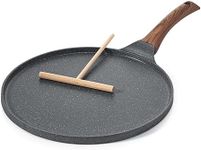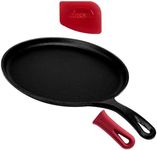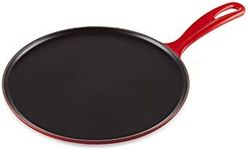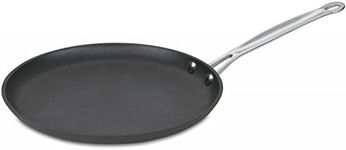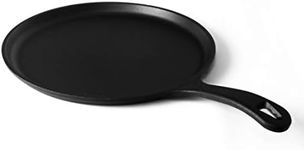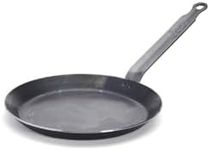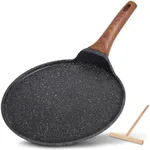Buying Guide for the Best Crepe Pans
Choosing the right crepe pan can make a big difference in how easy it is to make delicious, thin crepes at home. The best crepe pan for you will depend on your cooking habits, the type of stove you have, and how much effort you want to put into maintenance. Understanding the key features of crepe pans will help you pick one that matches your needs and makes crepe-making a fun and successful experience.MaterialThe material of a crepe pan affects how evenly it heats, how easy it is to clean, and how much care it needs. Common materials include nonstick, cast iron, carbon steel, and stainless steel. Nonstick pans are easy to use and clean, making them great for beginners or those who want quick results. Cast iron and carbon steel pans heat very evenly and can last a lifetime, but they require seasoning and a bit more care to prevent rust. Stainless steel pans are durable but can be harder to use for crepes because they may stick more. If you want low maintenance and easy release, go for nonstick. If you enjoy traditional cooking and don’t mind a little upkeep, cast iron or carbon steel could be a good fit.
Size (Diameter)The size of the crepe pan determines how big your crepes will be. Most crepe pans range from about 8 to 12 inches in diameter. Smaller pans (8-9 inches) are easier to handle and good for making small, snack-sized crepes. Medium pans (10 inches) are versatile and work well for most home cooks. Larger pans (11-12 inches) are great if you want to make big, restaurant-style crepes, but they can be harder to maneuver. Think about how you plan to serve your crepes and how much space you have on your stove when choosing the size.
WeightThe weight of a crepe pan affects how easy it is to handle, especially when swirling batter or flipping crepes. Lightweight pans are easier to lift and move, which is helpful for beginners or anyone with limited strength. Heavier pans, like cast iron, retain heat better and cook more evenly, but they can be tiring to use for long periods. If you want something easy to handle, look for a lighter pan. If you value even cooking and don’t mind the extra weight, a heavier pan might be right for you.
Handle DesignThe handle of a crepe pan should be comfortable to hold and stay cool during cooking. Some handles are made of metal, while others have heat-resistant coatings or are made of wood. A longer handle can make it easier to swirl the batter and flip crepes, but it might take up more space. If you have small hands or limited storage, a shorter handle might be better. Choose a handle that feels comfortable and safe for you to use.
Edge HeightCrepe pans usually have low, gently sloping sides to make it easy to spread the batter and flip the crepes. Some pans have slightly higher edges, which can help prevent batter from spilling but might make flipping a bit harder. If you’re new to making crepes, a pan with very low sides will make the process easier. If you want a bit more versatility for other types of cooking, a pan with slightly higher edges could be useful.
Compatibility with CooktopsNot all crepe pans work on every type of stove. Some pans, especially those made of certain metals, may not be compatible with induction cooktops. If you have an induction stove, make sure the pan is labeled as induction-compatible. For gas and electric stoves, most pans will work, but it’s still good to check. Pick a pan that matches your stove type to avoid any issues.
Ease of CleaningHow easy a crepe pan is to clean depends on its material and whether it has a nonstick coating. Nonstick pans are the easiest to clean, usually needing just a quick wipe. Cast iron and carbon steel pans need to be seasoned and dried thoroughly to prevent rust, which adds a bit of maintenance. Stainless steel pans can go in the dishwasher but may require more scrubbing. If you want minimal cleanup, a nonstick pan is the best choice. If you don’t mind a little extra care, other materials can offer great results.
